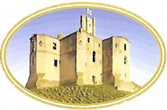The Hermitage

The Hermitage is a hidden gem of our area with an interesting past but what is the real story of its origins?
The Hermitage is a chantry chapel carved into the sandstone cliff-face on the north bank of the River Coquet, half a mile up-stream from Warkworth Castle and village. It is not a rough-hewn cave, rather a miniature church carved by master stone masons. It is completely hidden from view behind a canopy of mature trees and only accessible by boat from a landing stage on the opposite bank of the river.
It was probably constructed in the early 1400s but by whom is where the debate starts. Current thinking is that this was built by order of the 1st Earl of Northumberland, Henry Percy, who would have employed a live-in priest to say prayers for him and his family. Certainly, there are records of clergy at the chapel from 1489 to 1536. So not quite the bolt-hole for a recluse seeking a solitary existence normally associated with a traditional hermitage.
By comparison, the ‘traditional story’ attributes the building of the hermitage to one of the Bertram family of Bothal Castle, a knight of the first Earl of Northumberland. He had killed his intended bride, Isabel and his brother by mistake. In redemption he gave all his worldly goods to the poor becoming the hermit Benedict and with the Earl’s permission carved the Hermitage in penance. This version is told in the ballad The Hermit of Warkworth which was written by Reverend Dr. Thomas Percy in 1771. The ballad was based on a manuscript of ancient ballads now known as the ‘Percy Folio’ which Revd. Percy apparently rescued from being used as fire-kindling during his search for the history of the Percy family in Northumberland. He further supported the traditional story of the origins of the hermitage as this was the story passed down to local folk as warranted to him by the Reverends Wilfred Lawson, father and son, who were the Rectors of Warkworth from 1717 to 1770.

Photo Richard Booth
The original hermitage comprised a chapel, sacristy / vestry and porch carved into the sandstone cliff with living quarters to the West. In the 15th century the accommodation was improved with a hall, kitchen and upper chamber built from stone externally to the Hermitage.
The chapel comprise three vaulted bays beautifully carved into the sandstone. At one end an altar is carved from the rock and is thought to be the only altar in Northumberland not defaced during the religious Reformation of the 16th century. At the righthand end of the altar, in front of the window, is a tableau of almost life-sized carvings which is where opinions vary. Current thinking is that these depict the nativity but Revd. Percy argued that the Virgin Mary is never depicted lying down. He believed that this represents the tomb of Bertram’s slain bride Isabel with its female figure lying on top, an angel above and the crest of a bull’s head at her feet; the bull’s head being the crest of Isabel’s family, the Widdringtons.
The sacristy / vestry is seen through an ornately carved viewing window typical of the 14th century. It is thought that this would allow the Earl and family to watch the priest’s service in the adjoining chapel. Above the doorway into the vestry is a carved shield which bore the symbols of the Passion with an inscription which translates as “ My tears have been my meat night and day”. The vestry itself is a simple arch-roofed chamber with two recesses set into the rock walls.

Photo Richard Booth
The 15th century stone built rooms were more spacious but are now roofless; the outer walls stand 4m tall with a window opening and chimneybreast and have markings of historic flood levels cut into the stone. Little remains of the kitchen apart from the round base of an oven. To the right of the chapel is a staircase tunnel carved into the rock which leads to the top of the cliff where the hermit had a garden.

Photo Richard Booth
So which of the two versions do you believe, the Chantry ordered by the Earl of Northumberland to appease his soul, or the passionate grieving of the hermit Benedict? Unfortunately, time (and vandals) have not been kind to the sandstone carvings and much detail has been lost since Revd. Thomas Percy described the Hermitage 250 years ago, so we will probably never know for sure.
In years past the Hermitage was used to celebrate Holy Communion on Trinity Sunday which is a custom that the local benefice still continue.
Today the Hermitage is a managed by English Heritage who provide boat access during the summer months; apparently a new boat is currently being sourced and the public should be able to access the site again shortly, it’s well worth a visit!

